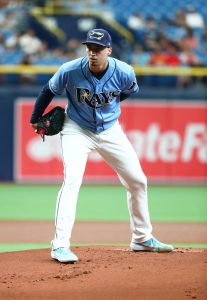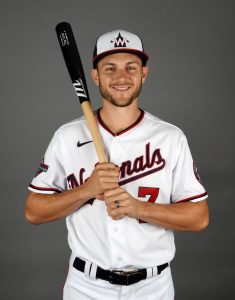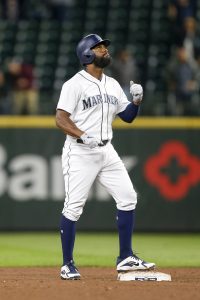Last week, I looked at Cole Sulser’s prospects of making an impact in the Baltimore Orioles bullpen. Sulser found his way to Baltimore via Tampa Bay after being included in a three-way swap of more prominent players. Today, let’s take a look at those players.
To review: in December of 2018, the Indians, Mariners, and Rays engaged in a three-way deal that shuffled around their first basemen. In this rare three-way challenge trade, each team came away with (at least one) major-league first baseman. The Rays got Yandy Diaz, the Mariners Edwin Encarnacion, while the Indians snagged a pair of first basemen in the deal: Jake Bauers and Carlos Santana.
There were auxiliary pieces that fit less cleanly into our first basemen carousel. The Rays picked up Sulser from Cleveland, while Tampa also sent $5MM to the Mariners. Seattle paid that money forward, sending a total of $6MM to the Indians. Coming back to Seattle was the Indians’ Round B selection in the draft. The Mariners ended up selecting right-handed pitcher Isaiah Campbell out of Arkansas with the #76 pick in the draft. Those pieces aside, let’s check in on how each team is feeling about their end of this whirlwind deal one season after the fact.
Indians
This move – and much of their offseason last winter – was largely about shuffling money around – but not wholly so. The Indians took back Santana, who had only recently been sent to Seattle after playing one season in Philadelphia. Santana made $20.3MM in 2019, but his contract was offset by sending out Encarnacion, who was owed $21.7MM in 2019 with a $5MM buyout for 2020. The difference in their salaries, plus the money acquired from Seattle netted the Indians close to $7.5MM in 2019, though they took on more long-term money in Santana.
On the field, this deal basically amounts to two exchanges for the Indians: Santana over Encarnacion in terms of big-money players, and Bauers over Diaz for cost-controlled assets. As for the first exchange, the Indians have to count this as a win. After one so-so year with the Phillies, Santana returned to form in a big way with the Indians. All aspects of Santana’s game came together in 2019. He hit .281/.397/.515 on the year with 34 home runs and 110 RBIs. He turned in his typically strong BB-K numbers, posting identical walk and strikeout rates of 15.7% (slight improvements on his career norms in both departments). His isolated power (.234 ISO) was the second-highest mark of his career, while the .397 OBP was a new career-high for a full season. Santana’s season totaled 4.6rWAR/4.4 fWAR, good for 135 wRC+, and he’ll be back in their lineup for 2020.
Bauers, on the other hand, is a work in progress. He brings an added level of versatility, appearing in 31 games at first and 53 games in left, but he’ll need to improve at the plate to put that value to work. Bauers hit just .226/.312/.371 across 423 plate appearances in his first season with the Indians. His walk rate dropped to 10.6% and with a power mark of just .145 ISO. That’s not enough pop from a first baseman/left fielder. He finished with below-average marks of 78 wRC+ and -0.4 fWAR. Still, all hope is not lost for Bauers. A career-low .290 BABIP might point to some positive regression in the future, and he doesn’t even turn 25-years-old until October.
Mariners
The Mariners’ biggest get here was the draft pick. GM Jerry Dipoto continued his rebuild, and ultimately, the swap of sluggers was an avenue to add another draft pick. After taking on Santana a week prior, the Mariners shed long-term money by swapping in Encarnacion, whom they eventually flipped to the Yankees.
While with the Mariners, Encarnacion was about as good as expected, slashing .241/.356/.531 with 21 home runs in 65 games. With the rebuild in full swing, EE was never expected to spend a full season in Seattle. Given his start to the year, the Mariners’ return for the DH was a little underwhelming, but the market for teams in need of a designated hitter was limited. Still, Trader Jerry added right-hander Juan Then from the Yankees. Fangraphs ranks Then as the Mariners’ #13-ranked prospect after finishing the season in A-ball. Campbell, selected with the acquired draft choice, comes in at #16.
The Yankees and Mariners essentially split the remaining money owed Encarnacion at the time, so the M’s did see some financial benefit as well. It’s often difficult to track the wheeling and dealing done by Dipoto, but we can give it a go here. To do so, we have to go back to the deal that sent Santana from the Phillies to Seattle. Dipoto sent Jean Segura, Juan Nicasio, and James Pazos to Philly for Santana and J.P. Crawford. In sum, he started with Segura, Nicasio, and Pazos, and the Mariners ended up with Crawford, Then, and Campbell, along with some financial saving both in the short-and-long-term.
Rays
It was surprising to see the Rays move Jake Bauers at the time of this deal, but they’re no stranger to dealing from a young core. The Rays picked up Sulser and Diaz for Bauers in this trade, while also sending $5MM to the Mariners. Considering Sulser was eventually lost on waivers to the Orioles (though he did give them 7 scoreless innings in 2019), the move essentially amounts to the Rays paying $5MM to swap in Diaz for Bauers. At the time of the deal, Bauers was seen as an up-and-comer, while Diaz was a little-known 27-year-old utility player with little-to-no boom in his boomstick. As has often been the case of late with Rays’ trades, at a cursory glance, the Rays were trading away controllable youth for a role player.
But where the Rays are concerned, it’s often worth delving a little further. Diaz quickly became known for his above-average exit velocities. And while Diaz was a little older and without the prospect pedigree of Bauers, he came with similar team control, more versatility given his ability to line up at the hot corner, and his biceps have a cult following all their own.
Injuries unfortunately limited Diaz’s production in 2019, but when he was on the field, he was dynamite. While posting a line of .267/.340/.476 across 79 games, Diaz was coming into his own as a hitter with a 116 wRC+. Diaz’s minor league career to this point was a testament to his ability to get on base, limit strikeouts, and make hard contact, but a groundball-heavy approach limited his power.
But it was a different story in Tampa. Diaz produced a career-best .208 ISO to go with a 91.7 mph exit velocity that put him in the top 8% of the league, per Statcast. His hard-hit percentage continues to be well above average, and a small improvement in launch angle and a large jump in barrels led to Diaz smashing 14 home runs in 79 games after hitting just 1 in 88 big league games with the Indians.
Not only that, but Diaz returned from the injured list in time for the playoffs, leading off the wild card game with a solo shot off Sean Manaea. Diaz went deep his second time up as well, at which point the Rays had more than enough to get past the A’s. It was a monster performance from Diaz in the biggest game of the year up to that point. (Things didn’t go quite so well for Diaz in Houston, as he went 0 for 9 with four strikeouts in the ALDS.) The Rays have to feel pretty good about where they stand with Diaz moving forward, as he should continue to be a cheap source of offense for the next couple of seasons.
For that matter, all three teams have to feel pretty good about this deal, as they each accomplished their goal. If Bauers has a better showing in 2020 and the Mariners’ prospects come to fruition, there will ultimately be very little not to like about this three-way deal. Include the Orioles for nabbing Sulser and the Yankees for getting a half a season of Encarnacion, and it could be argued that five teams actually came away winners from this three-way swap of first baseman.



